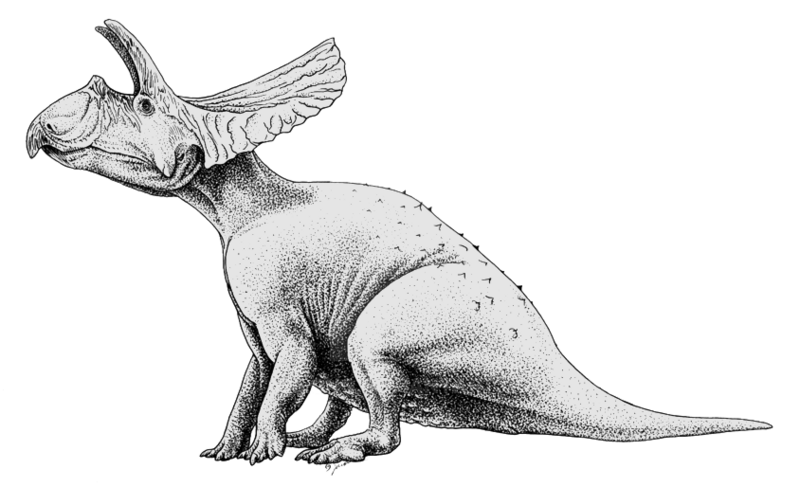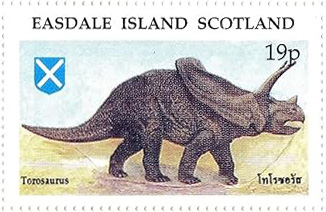Torosaurus sp.

Ill.: Jaime A. Headden
(Da: en.wikipedia.org)
Phylum: Chordata Haeckel, 1874
Subphylum: Vertebrata Cuvier, 1812
Classe: Dinosauria Owen, 1841
Ordine: Ornithischia Seeley, 1888
Famiglia: Ceratopsidae Marsh, 1890
Genere: Torosaurus Marsh, 1891
Specie e sottospecie
Il genere annovera attualmente la seguente specie: la specie tipo Torosaurus latus e la possibile specie Torosaurus utahensis.
Descrizione
Possedeva uno dei più grandi crani di qualsiasi altro animale terrestre noto. L'intero cranio, contando anche il grande collare osseo, raggiungeva fino a 2,77 metri di lunghezza. Dalla testa alla coda, si presume che l'animale avesse una lunghezza complessiva di circa 8-9 m, per un peso di 4-6 tonnellate. Il Torosaurus si distingue dal contemporaneo Triceratops per il suo collare più stretto e allungato e dotato di grandi aperture (fenestrae), per le lunghe ossa squamosali che compongono la parte inferiore del collare, e la presenza di cinque o più paia di osteodermi o noduli ossei (epoccipitali) sul retro del collare. Un'altra caratteristica del Torosaurus era l'assenza del lungo corno nasale osservato in Triceratops prorsus, assomigliando di più alla condizione osservata nel Triceratops horridus provvisto di un corno più corto. Durante gli anni sono state nominate tre specie di Torosaurus: il Torosaurus latus, il Torosaurus gladius e il Torosaurus utahensis. Tuttavia, la specie Torosaurus gladius non è più considerata una specie valida. Nel 2010, la validità come genere di Torosaurus è stata messa in discussione. Uno studio sull'istologia delle ossa fossili combinato con un'indagine sulla forma del collare ha concluso che il
Diffusione
Torosaurus (il cui nome significa "lucertola perforata", in riferimento alle grandi aperture nel suo collare) è un genere estinto di dinosauro ceratopside chasmosaurino vissuto nel Cretaceo superiore, circa 68-66 milioni di anni fa, anche se è possibile che la gamma temporale della specie possa essersi esteso fino a 69 milioni di anni fa (Maastrichtiano), e i cui fossili sono stati scoperti attraverso l'entroterra occidentale del Nord America, dal Saskatchewan al sud del Texas.
Bibliografia
–Hicks, J.F., Johnson, K.R., Obradovich, J. D., Miggins, D.P., and Tauxe, L. 2003. Magnetostratigraphyof Upper Cretaceous (Maastrichtian) to lower Eocene strata of the Denver Basin, Colorado. In K.R. Johnson, R.G. Raynolds and M.L. Reynolds (eds), Paleontology and Stratigraphy of Laramide Strata in the Denver Basin, Pt. II., Rocky Mountain Geology 38: 1-27.
–Holtz, Thomas R. Jr. (2011) Dinosaurs: The Most Complete, Up-to-Date Encyclopedia for Dinosaur Lovers of All Ages, Winter 2010 Appendix. (PDF).
–Paul, G.S. (2010) The Princeton Field Guide to Dinosaurs, Princeton University Press.
–Longrich, N. R. e Field, D. J., Torosaurus is not Triceratops: Ontogeny in chasmosaurine ceratopsids as a case study in dinosaur taxonomy, in PLoS ONE, vol. 7, n. 2, 2012.
–Morph-osaurs: How shape-shifting dinosaurs deceived us - life - 28 July 2010, su newscientist.com, New Scientist.
–Scannella, J. and Horner, J.R. (2010). "Torosaurus Marsh, 1891, is Triceratops Marsh, 1889 (Ceratopsidae: Chasmosaurinae): synonymy through ontogeny ." Journal of Vertebrate Paleontology, 30(4): 1157-1168.
–Brian Switek, New Study Says Torosaurus=Triceratops, in Dinosaur Tracking, Smithsonian.com.
–Horner, Jack. TEDX Talks: " Shape-shifting Dinosaurs.
–Farke, A. A. (2011) " Anatomy and taxonomic status of the chasmosaurine ceratopsid Nedoceratops hatcheri from the Upper Cretaceous Lance Formation of Wyoming, U.S.A..." PLoS ONE 6 (1).
–Maiorino L., Farke A.A., Kotsakis T., Piras P.,2013, "Is Torosaurus Triceratops? Geometric Morphometric Evidence of Late Maastrichtian Ceratopsid Dinosaurs", PLoS ONE 8(11).
–Hatcher, J.B., Marsh O.C. and Lull, R.S., 1907, The Ceratopsia, Monographs of the United States Geological Survey 49: 1-198.
–Lull, R.S., 1933, A revision of the Ceratopsia or horned dinosaurs, Memoirs of the Peabody Museum of Natural History 3(3): 1-175.
–Lehman, T.M., 1998, "A gigantic skull and skeleton of the horned dinosaur Pentaceratops sternbergi from New Mexico: Journal of Paleontology, 72(5): 894-906.
–Nicholas R. Longrich, 2011, "Titanoceratops ouranous, a giant horned dinosaur from the Late Campanian of New Mexico", Cretaceous Research, 32: 264-276.
–Farke, A. A. "Cranial osteology and phylogenetic relationships of the chasmosaurine ceratopsid Torosaurus latus", pp. 235-257. In K. Carpenter (ed.). Horns and Beaks: Ceratopsian and Ornithopod Dinosaurs. Indiana Univ. Press (Bloomington), 2006.
–Hunt, Rebecca K. and Thomas M. Lehman. 2008. Attributes of the ceratopsian dinosaur Torosaurus, and new material from the Javelina Formation (Maastrichtian) of Texas. Journal of Paleontology 82(6): 1127-1138.
–O.C. Marsh, 1891, "Notice of new vertebrate fossils", The American Journal of Science, series 3 42: 265-269.
–Scott D. Sampson, Mark A. Loewen, Andrew A. Farke, Eric M. Roberts, Catherine A. Forster, Joshua A. Smith e Alan A. Titus, New Horned Dinosaurs from Utah Provide Evidence for Intracontinental Dinosaur Endimism, in PLoS ONE, 5, vol. 5, n. 9, 2010.
–N. R. Longrich, The horned dinosaurs Pentaceratops and Kosmoceratops from the upper Campanian of Alberta and implications for dinosaur biogeography, in Cretaceous Research, vol. 51, 2014, pp. 292-308.
–Dodson, P. The Horned Dinosaurs. Princeton Univ. Press (Princeton), 1996.
–Colbert, E.H. and J.D. Bump, 1947, "A skull of Torosaurus from South Dakota and a revision of the genus:, Proceedings of the Academy of Natural Sciences of Philadelphia, 99: 93-106.
–Farke, A., 2002, "A review of Torosaurus (Dinosauria: Ceratopsidae) specimens from Texas and New Mexico", Journal of Vertebrate Paleontology, 22: 52°.
–Lucas, S.G., Mack, G.H., Estep, G.W., 1998, "The Ceratopsian dinosaur Torosaurus from the Upper Cretaceous McRae Formation, Sierra County, New Mexico", New Mexico Geological Society Guidebook, 49th Field Conference, Las Cruces County II.
–C.W. Gilmore, 1946, "Reptilian fauna of the North Horn Formation of central Utah", United States Department of the Interior Geological Survey Professional Paper 210-C: 29-53
–D.A. Lawson, 1976, "Tyrannosaurus and Torosaurus, Maestrichtian dinosaurs from Trans-Pecos, Texas", Journal of Paleontology 50(1): 158-164.
–Sullivan, R. M., A. C. Boere, and S. G. Lucas. 2005. Redescription of the ceratopsid dinosaur Torosaurus utahensis (Gilmore, 1946) and a revision of the genus. Journal of Paleontology 79: 564-582.
–Scannella J., 2009, "And then there was one: synonymy consequences of Triceratops cranial ontogeny", Journal of Vertebrate Paleontology 29: 177.
–New Analyses Of Dinosaur Growth May Wipe Out One-third Of Species, su sciencedaily.com, 31 ottobre 2009.
–John R Horner e Mark B Goodwin, Extreme Cranial Ontogeny in the Upper Cretaceous Dinosaur Pachycephalosaurus, in PLoS ONE, vol. 4, n. 10, 2009, pp. e7626.
–Scannella, J.B. & Horner, J.R., 2011, "‘Nedoceratops’: An Example of a Transitional Morphology", PLoS ONE 6(12).
–Horner, J.R., Lamm, E-T., 2011, "Ontogeny of the parietal frill of Triceratops: a preliminary histological analysis", Comptes Rendus de l’Academie des Sciences Paris série D 10: 439-452.
–Jordan C Mallon, Robert B Holmes, Emily L Bamforth e Dirk Schumann, The record of Torosaurus (Ornithischia: Ceratopsidae) in Canada and its taxonomic implications, in Zoological Journal of the Linnean Society, vol. 195, n. 1, 7 maggio 2022, pp. 157-171.

|
Emissione: Fauna preistorica - Singapore 95 Stato: Easdale Island Nota: Emesso in un foglietto di 4 v. diversi |
|---|